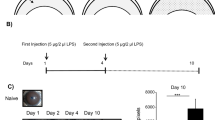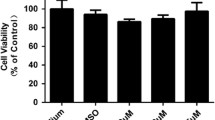Abstract
The bacterial keratitis causes viability loss and apoptosis in the corneal epithelial cells (CECs). The cyanidin-3-O-glucoside (C3G) benefits visual system and also possess anti-bacterial and anti-inflammatory potentials. In the current study, the effects of C3G on human CECs (HCECs) against bacterial lipopolysaccharide (LPS)-induced disorders were assessed, and the mechanism driving the protective effect was explored by focusing on let-7b-5p-mediated HMGA2/PI3K/Akt pathway. The HCECs were incubated LPS of P. aeruginosa to induce inflammation and apoptosis, and then treated with C3G. The changes in cell viability, apoptosis, and inflammation were detected. Moreover, the effects of LPS and C3G on let-7b-5p level and HMGA2/PI3K/Akt pathway activity were also assessed. Thereafter, the HCECs were further transfected with let-7b-5p inhibitor to confirm its role in the vision-protective effects of C3G. The interaction between let-7b-5p and HMGA2 was verified with dual luciferase assay. The LPS treatment suppressed viability and induced apoptosis and inflammation in HCECs, which was associated with the down-regulated let-7b-5p level and up-regulated HMGA2/PI3K/Akt pathway activity. The impairments of LPS on HCECs were attenuated by C3G: the compound increased cell viability and inhibited apoptosis and inflammation. The C3G also induced let-7b-5p level and inactivated HMGA2/PI3K/Akt pathway. However, after the inhibition of let-7b-5p, the protective effects of C3G on HCECs against LPS were blocked. The results of dual luciferase assay showed the direct binding let-7b-5p to the promoter of HMGA2 gene. It was inferred that the C3G could ameliorate the LPS-induced disorders in HCECs. The effect depended on the induced level of let-7b-5p, which then inhibited HMGA2/PI3K/Akt pathway.






Similar content being viewed by others
References
Xu, S., and L.D. Hazlett. 2019. MicroRNAs in ocular infection. Microorganisms 7 (9). https://doi.org/10.3390/microorganisms7090359.
Wong, V.W., T.Y. Lai, S.C. Chi, and D.S. Lam. 2011. Pediatric ocular surface infections: a 5-year review of demographics, clinical features, risk factors, microbiological results, and treatment. Cornea 30 (9): 995–1002. https://doi.org/10.1097/ICO.0b013e31820770f4.
Bartel, D.P. 2004. MicroRNAs: genomics, biogenesis, mechanism, and function. Cell 116 (2): 281–297. https://doi.org/10.1016/s0092-8674(04)00045-5.
Horvitz, H.R., and J.E. Sulston. 1980. Isolation and genetic characterization of cell-lineage mutants of the nematode Caenorhabditis elegans. Genetics 96 (2): 435–454.
Ambros, V. 2004. The functions of animal microRNAs. Nature 431 (7006): 350–355. https://doi.org/10.1038/nature02871.
Wu, G., A. Liu, J. Zhu, F. Lei, S. Wu, X. Zhang, L. Ye, L. Cao, and S. He. 2015. MiR-1207 overexpression promotes cancer stem cell-like traits in ovarian cancer by activating the Wnt/beta-catenin signaling pathway. Oncotarget 6 (30): 28882–28894. https://doi.org/10.18632/oncotarget.4921.
Kilpinen, L., A. Parmar, D. Greco, M. Korhonen, P. Lehenkari, P. Saavalainen, and S. Laitinen. 2016. Expansion induced microRNA changes in bone marrow mesenchymal stromal cells reveals interplay between immune regulation and cell cycle. Aging 8 (11): 2799–2812.
Wang, W., R. Zhou, Y. Wu, Y. Liu, W. Su, W. Xiong, and Z. Zeng. 2019. PVT1 promotes cancer progression via MicroRNAs. Frontiers in Oncology 9: 609. https://doi.org/10.3389/fonc.2019.00609.
Liu, Juan, Chang Ping Wu, Bin Feng Lu, and Jing Ting Jiang. 2013. Mechanism of T cell regulation by microRNAs. Cancer Biology & Medicine 10 (3): 131–137.
Lawrie, C.H. 2010. MicroRNAs and haematology: small molecules, big function. British Journal of Haematology 137 (6): 503–512.
Kun, Yang, Minhao Wu, Li Meiyu, Li Dandan, Peng Anping, Nie Xinxin, Sun Mingxia, Jinli Wang, Yongjian Wu, and Qiuchan Deng. 2014. miR-155 suppresses bacterial clearance in Pseudomonas aeruginosa-induced keratitis by targeting Rheb. Journal of Infectious Diseases 210 (1): 89.
Sandoval-Ramirez, B.A., U. Catalan, S. Fernandez-Castillejo, L. Rubio, A. Macia, and R. Sola. 2018. Anthocyanin tissue bioavailability in animals: possible implications for human health. A systematic review. Journal of Agricultural and Food Chemistry 66 (44): 11531–11543. https://doi.org/10.1021/acs.jafc.8b04014.
Camire, M.E. 2000. Bilberries and blueberries as functional foods and nutraceuticals. Herbs, Botanicals and Teas: Lancaster: Technomic Publishing Company.
Milenkovic, D., C. Deval, E. Gouranton, J.F. Landrier, A. Scalbert, C. Morand, and A. Mazur. 2012. Modulation of miRNA expression by dietary polyphenols in apoE deficient mice: a new mechanism of the action of polyphenols. PLoS One 7 (1): e29837. https://doi.org/10.1371/journal.pone.0029837.
Wu, J., X. Xue, B. Zhang, W. Jiang, H. Cao, R. Wang, D. Sun, and R. Guo. 2016. The protective effects of paeonol against epirubicin-induced hepatotoxicity in 4T1-tumor bearing mice via inhibition of the PI3K/Akt/NF-kB pathway. Chemico-Biological Interactions 244: 1–8. https://doi.org/10.1016/j.cbi.2015.11.025.
Tan, L., X. Wei, L. Zheng, J. Zeng, H. Liu, S. Yang, and H. Tan. 2016. Amplified HMGA2 promotes cell growth by regulating Akt pathway in AML. Journal of Cancer Research and Clinical Oncology 142 (2): 389–399. https://doi.org/10.1007/s00432-015-2036-9.
Wang, Q., M. Xia, C. Liu, H. Guo, Q. Ye, Y. Hu, Y. Zhang, M. Hou, H. Zhu, J. Ma, and W. Ling. 2008. Cyanidin-3-O-beta-glucoside inhibits iNOS and COX-2 expression by inducing liver X receptor alpha activation in THP-1 macrophages. Life Sciences 83 (5–6): 176–184. https://doi.org/10.1016/j.lfs.2008.05.017.
Speciale, A., R. Canali, J. Chirafisi, A. Saija, F. Virgili, and F. Cimino. 2010. Cyanidin-3-O-glucoside protection against TNF-alpha-induced endothelial dysfunction: involvement of nuclear factor-kappaB signaling. Journal of Agricultural and Food Chemistry 58 (22): 12048–12054. https://doi.org/10.1021/jf1029515.
Speciale, A., S. Anwar, R. Canali, J. Chirafisi, A. Saija, F. Virgili, and F. Cimino. 2013. Cyanidin-3-O-glucoside counters the response to TNF-alpha of endothelial cells by activating Nrf2 pathway. Molecular Nutrition & Food Research 57 (11): 1979–1987. https://doi.org/10.1002/mnfr.201300102.
Song, J., Y. Li, J. Ge, Y. Duan, S.C. Sze, Y. Tong, P.C. Shaw, et al. 2010. Protective effect of bilberry (Vaccinium myrtillus L.) extracts on cultured human corneal limbal epithelial cells (HCLEC). Phytotherapy Research 24 (4): 520–524. https://doi.org/10.1002/ptr.2974.
Ansari, Z., D. Miller, and A. Galor. 2013. Current thoughts in fungal keratitis: diagnosis and treatment. Current Fungal Infection Reports 7 (3): 209–218. https://doi.org/10.1007/s12281-013-0150-110.1007/s12281-013-0150-1.
Wong, R.L., R.A. Gangwani, L.W. Yu, and J.S. Lai. 2012. New treatments for bacterial keratitis. Journal of Ophthalmology 2012: 831502. https://doi.org/10.1155/2012/831502.
Yacout, S.M., and E.R. Gaillard. 2017. The anthocyanins, oenin and callistephin, protect RPE cells against oxidative stress. Photochemistry and Photobiology 93 (2): 590–599. https://doi.org/10.1111/php.12683.
Hee, Seung, Jeong Eojin Lee, Paik Sun-Sook, Jeon Ji Hyun, Jung Sung Won, Kim Hyun-Bok, Kim Muyan, Chun Myung-Hoon, and Kim In-Beom. 2014. Cyanidin-3-glucoside extracted from mulberry fruit can reduce N-methyl-N-nitrosourea-induced retinal degeneration in rats. Current Eye Research 39 (1): 79–87.
Wang, Y., Y. Huo, L. Zhao, F. Lu, O. Wang, X. Yang, B. Ji, and F. Zhou. 2016. Cyanidin-3-glucoside and its phenolic acid metabolites attenuate visible light-induced retinal degeneration in vivo via activation of Nrf2/HO-1 pathway and NF-kappaB suppression. Molecular Nutrition & Food Research 60 (7): 1564–1577. https://doi.org/10.1002/mnfr.201501048.
Matsumoto, H., Y. Nakamura, S. Tachibanaki, S. Kawamura, and M. Hirayama. 2003. Stimulatory effect of cyanidin 3-glycosides on the regeneration of rhodopsin. Journal of Agricultural and Food Chemistry 51 (12): 3560–3563. https://doi.org/10.1021/jf034132y.
Jang, Y.P., J. Zhou, K. Nakanishi, and J.R. Sparrow. 2005. Anthocyanins protect against A2E photooxidation and membrane permeabilization in retinal pigment epithelial cells. Photochemistry and Photobiology 81 (3): 529–536. https://doi.org/10.1562/2004-12-14-RA-402.
Tirupula, K.C., F. Balem, N. Yanamala, and J. Klein-Seetharaman. 2009. pH-dependent interaction of rhodopsin with cyanidin-3-glucoside. 2. Functional aspects. Photochemistry and Photobiology 85 (2): 463–470. https://doi.org/10.1111/j.1751-1097.2008.00533.x.
Derrick, Tamsyn, Anna R. Last, Sarah E. Burr, Chrissy H. Roberts, Meno Nabicassa, Eunice Cassama, Robin L. Bailey, David C. W. Mabey, Matthew J. Burton, and Martin J. Holland. 2015. Inverse relationship between microRNA-155 and -184 expression with increasing conjunctival inflammation during ocular Chlamydia trachomatis infection. BMC Infectious Diseases 16 (1):60.
Graham, J., Ruby, Calvin H. Jan, and David P. Bartel. 2007. Intronic microRNA precursors that bypass Drosha processing. Nature 448 (7149): 83–86.
Ye, Jing, Hongmei Piao, Jingzhi Jiang, Guangyu Jin, Mingyu Zheng, Jinshi Yang, Xiang Jin, Tianyi Sun, Yun Ho Choi, and Liangchang Li. Polydatin inhibits mast cell-mediated allergic inflammation by targeting PI3K/Akt, MAPK, NF-κB and Nrf2/HO-1 pathways. Scientific Reports 7 (1): 11895.
Wang, Lili, Yan Xu, Qi Yu, Qiao Sun, Yi Xu, Gu Qing, and Xu. Xun. H-RN, a novel antiangiogenic peptide derived from hepatocyte growth factor inhibits inflammation in vitro and in vivo through PI3K/AKT/IKK/NF-κB signal pathway. Biochemical Pharmacology 89 (2): 255–265.
Huang, H., H. Li, X. Chen, Y. Yang, X. Li, W. Li, C. Huang, X. Meng, L. Zhang, and J. Li. 2017. HMGA2, a driver of inflammation, is associated with hypermethylation in acute liver injury. Toxicology and Applied Pharmacology 328: 34.
Author information
Authors and Affiliations
Corresponding author
Ethics declarations
Conflict of Interests
The authors declare that they have no conflict of interests.
Additional information
Publisher’s Note
Springer Nature remains neutral with regard to jurisdictional claims in published maps and institutional affiliations.
Electronic Supplementary Material
ESM 1
(DOCX 16 kb)
Rights and permissions
About this article
Cite this article
Li, X., Sun, M. & Long, Y. Cyanidin-3-O-Glucoside Attenuates Lipopolysaccharide-Induced Inflammation in Human Corneal Epithelial Cells by Inducing Let-7b-5p-Mediated HMGA2/PI3K/Akt Pathway. Inflammation 43, 1088–1096 (2020). https://doi.org/10.1007/s10753-020-01194-0
Published:
Issue Date:
DOI: https://doi.org/10.1007/s10753-020-01194-0




